Estimation and Simulation of Forest Carbon Stock in Northeast China Forestry Based on Future Climate Change and LUCC
Abstract
:1. Introduction
2. Materials and Methods
2.1. Study Area and Data
2.1.1. Study Area
2.1.2. Data Acquisition and Preprocessing
2.2. Methods
2.2.1. Patch-Generation Land Use Change Simulation (PLUS) Model
2.2.2. InVEST Model and Forest Carbon Density Settings
2.2.3. InVEST Carbon Storage and Sequestration Model
3. Results
3.1. Model Validation
3.2. Multiple Scenario Settings Based on the Amount of Land Demand
3.3. NCF Land Use Evolution Analysis
3.3.1. Historical Land Use Evolution Analysis
3.3.2. Simulation of Future Land Use Evolution
- Changes in the areas of the main land types
- 2.
- Intensity of conversion between land classes.
3.4. Spatial and Temporal Changes in Forest Carbon Stocks
3.4.1. FCS Evolution in a Historical Period
3.4.2. Characteristics of Future Changes in FCS
4. Discussion
4.1. Limitations, Uncertainties, and Prospects
4.2. Carbon Effects from Natural Forests
4.3. Value Transformation of Forest Carbon Sequestration
5. Conclusions
Author Contributions
Funding
Data Availability Statement
Acknowledgments
Conflicts of Interest
References
- Lu, F.; Hu, H.; Sun, W.; Zhu, J.; Liu, G.; Zhou, W.; Zhang, Q.; Shi, P.; Liu, X.; Wu, X.; et al. Effects of National Ecological Restoration Projects on Carbon Sequestration in China from 2001 to 2010. Proc. Natl. Acad. Sci. USA 2018, 115, 4039–4044. [Google Scholar] [CrossRef] [PubMed] [Green Version]
- Harris, N.L.; Gibbs, D.A.; Baccini, A.; Birdsey, R.A.; de Bruin, S.; Farina, M.; Fatoyinbo, L.; Hansen, M.C.; Herold, M.; Houghton, R.A.; et al. Global Maps of Twenty-First Century Forest Carbon Fluxes. Nat. Clim. Chang. 2021, 11, 234–240. [Google Scholar] [CrossRef]
- Fang, J.; Guo, Z.; Hu, H.; Kato, T.; Muraoka, H.; Son, Y. Forest Biomass Carbon Sinks in East Asia, with Special Reference to the Relative Contributions of Forest Expansion and Forest Growth. Glob. Chang. Biol. 2014, 20, 2019–2030. [Google Scholar] [CrossRef] [PubMed]
- Hua, F.; Wang, X.; Zheng, X.; Fisher, B.; Wang, L.; Zhu, J.; Tang, Y.; Yu, D.W.; Wilcove, D.S. Opportunities for Biodiversity Gains under the World’s Largest Reforestation Programme. Nat. Commun. 2016, 7, 12717. [Google Scholar] [CrossRef] [Green Version]
- Piao, S.; Yue, C.; Ding, J.; Guo, Z. Perspectives on the Role of Terrestrial Ecosystems in the ‘Carbon Neutrality’ Strategy. Sci. China Earth Sci. 2022, 65, 1178–1186. [Google Scholar] [CrossRef]
- Fang, J.; Wang, G.G.; Liu, G.; Xu, S. Forest Biomass of China: An Estimate Based on the Biomass–Volume Relationship. Ecol. Appl. 1998, 8, 1084–1091. [Google Scholar] [CrossRef]
- Guo, Z.; Fang, J.; Pan, Y.; Birdsey, R. Inventory-Based Estimates of Forest Biomass Carbon Stocks in China: A Comparison of Three Methods. For. Ecol. Manag. 2010, 259, 1225–1231. [Google Scholar] [CrossRef]
- He, N.; Wen, D.; Zhu, J.; Tang, X.; Xu, L.; Zhang, L.; Hu, H.; Huang, M.; Yu, G. Vegetation Carbon Sequestration in Chinese Forests from 2010 to 2050. Glob. Chang. Biol. 2017, 23, 1575–1584. [Google Scholar] [CrossRef]
- Hu, H.; Wang, S.; Guo, Z.; Xu, B.; Fang, J. The Stage-Classified Matrix Models Project a Significant Increase in Biomass Carbon Stocks in China’s Forests between 2005 and 2050. Sci. Rep. 2015, 5, 11203. [Google Scholar] [CrossRef] [Green Version]
- Luo, W.; Kim, H.S.; Zhao, X.; Ryu, D.; Jung, I.; Cho, H.; Harris, N.; Ghosh, S.; Zhang, C.; Liang, J. New Forest Biomass Carbon Stock Estimates in Northeast Asia Based on Multisource Data. Glob. Chang. Biol. 2020, 26, 7045–7066. [Google Scholar] [CrossRef]
- Piao, S.; Fang, J.; Ciais, P.; Peylin, P.; Huang, Y.; Sitch, S.; Wang, T. The Carbon Balance of Terrestrial Ecosystems in China. Nature 2009, 458, 1009–1013. [Google Scholar] [CrossRef]
- Fang, J.; Shen, Z.; Tang, Z.; Wang, X.; Wang, Z.; Feng, J.; Liu, Y.; Qiao, X.; Wu, X.; Zheng, C. Forest Community Survey and the Structural Characteristics of Forests in China. Ecography 2012, 35, 1059–1071. [Google Scholar] [CrossRef]
- Tang, X.; Zhao, X.; Bai, Y.; Tang, Z.; Wang, W.; Zhao, Y.; Wan, H.; Xie, Z.; Shi, X.; Wu, B.; et al. Carbon Pools in China’s Terrestrial Ecosystems: New Estimates Based on an Intensive Field Survey. Proc. Natl. Acad. Sci. USA 2018, 115, 4021–4026. [Google Scholar] [CrossRef] [Green Version]
- Piao, S.; He, Y.; Wang, X.; Chen, F. Estimation of China’s Terrestrial Ecosystem Carbon Sink: Methods, Progress and Prospects. Sci. China Earth Sci. 2022, 65, 641–651. [Google Scholar] [CrossRef]
- Sun, W.; Liu, X. Review on Carbon Storage Estimation of Forest Ecosystem and Applications in China. For. Ecosyst. 2019, 7, 4. [Google Scholar] [CrossRef] [Green Version]
- Griscom, B.W.; Adams, J.; Ellis, P.W.; Houghton, R.A.; Lomax, G.; Miteva, D.A.; Schlesinger, W.H.; Shoch, D.; Siikamäki, J.V.; Smith, P.; et al. Natural Climate Solutions. Proc. Natl. Acad. Sci. USA 2017, 114, 11645–11650. [Google Scholar] [CrossRef] [Green Version]
- Chang, X.; Xing, Y.; Wang, J.; Yang, H.; Gong, W. Effects of Land Use and Cover Change (LUCC) on Terrestrial Carbon Stocks in China between 2000 and 2018. Resour. Conserv. Recycl. 2022, 182, 106333. [Google Scholar] [CrossRef]
- Homer, C.; Dewitz, J.; Jin, S.; Xian, G.; Costello, C.; Danielson, P.; Gass, L.; Funk, M.; Wickham, J.; Stehman, S.; et al. Conterminous United States Land Cover Change Patterns 2001–2016 from the 2016 National Land Cover Database. ISPRS J. Photogramm. Remote Sens. 2020, 162, 184–199. [Google Scholar] [CrossRef]
- Hua, F.; Bruijnzeel, L.A.; Meli, P.; Martin, P.A.; Zhang, J.; Nakagawa, S.; Miao, X.; Wang, W.; McEvoy, C.; Peña-Arancibia, J.L.; et al. The Biodiversity and Ecosystem Service Contributions and Trade-Offs of Forest Restoration Approaches. Science 2022, 376, 839–844. [Google Scholar] [CrossRef]
- Huang, W. Forest Condition Change, Tenure Reform, and Government-Funded Eco-Environmental Programs in Northeast China. For. Policy Econ. 2019, 98, 67–74. [Google Scholar] [CrossRef]
- Naime, J.; Mora, F.; Sánchez-Martínez, M.; Arreola, F.; Balvanera, P. Economic Valuation of Ecosystem Services from Secondary Tropical Forests: Trade-Offs and Implications for Policy Making. For. Ecol. Manag. 2020, 473, 118294. [Google Scholar] [CrossRef]
- Seibold, S.; Rammer, W.; Hothorn, T.; Seidl, R.; Ulyshen, M.D.; Lorz, J.; Cadotte, M.W.; Lindenmayer, D.B.; Adhikari, Y.P.; Aragón, R.; et al. The Contribution of Insects to Global Forest Deadwood Decomposition. Nature 2021, 597, 77–81. [Google Scholar] [CrossRef]
- Li, Y.; Piao, S.; Li, L.Z.X.; Chen, A.; Wang, X.; Ciais, P.; Huang, L.; Lian, X.; Peng, S.; Zeng, Z.; et al. Divergent Hydrological Response to Large-Scale Afforestation and Vegetation Greening in China. Sci. Adv. 2018, 4, eaar4182. [Google Scholar] [CrossRef] [Green Version]
- Wang, S.; Zhou, C.; Liu, J.; Tian, H.; Li, K.; Yang, X. Carbon Storage in Northeast China as Estimated from Vegetation and Soil Inventories. Environ. Pollut. 2002, 116, S157–S165. [Google Scholar] [CrossRef]
- Wang, X.; Wang, S.; Dai, L. Estimating and Mapping Forest Biomass in Northeast China Using Joint Forest Resources Inventory and Remote Sensing Data. J. For. Res. 2018, 29, 797–811. [Google Scholar] [CrossRef]
- Wei, Y.; Yu, D.; Lewis, B.J.; Zhou, L.; Zhou, W.; Fang, X.; Zhao, W.; Wu, S.; Dai, L. Forest Carbon Storage and Tree Carbon Pool Dynamics under Natural Forest Protection Program in Northeastern China. Chin. Geogr. Sci. 2014, 24, 397–405. [Google Scholar] [CrossRef]
- Wei, Y.; Li, M.; Chen, H.; Lewis, B.J.; Yu, D.; Zhou, L.; Zhou, W.; Fang, X.; Zhao, W.; Dai, L. Variation in Carbon Storage and Its Distribution by Stand Age and Forest Type in Boreal and Temperate Forests in Northeastern China. PLoS ONE 2013, 8, e72201. [Google Scholar] [CrossRef] [Green Version]
- Dong, L.; Lu, W.; Liu, Z. Developing Alternative Forest Spatial Management Plans When Carbon and Timber Values Are Considered: A Real Case from Northeastern China. Ecol. Model. 2018, 385, 45–57. [Google Scholar] [CrossRef]
- Liang, X.; Liu, X.; Li, X.; Chen, Y.; Tian, H.; Yao, Y. Delineating Multi-Scenario Urban Growth Boundaries with a CA-Based FLUS Model and Morphological Method. Landsc. Urban Plan. 2018, 177, 47–63. [Google Scholar] [CrossRef]
- Liang, X.; Liu, X.; Li, D.; Zhao, H.; Chen, G. Urban Growth Simulation by Incorporating Planning Policies into a CA-Based Future Land-Use Simulation Model. Int. J. Geogr. Inf. Sci. 2018, 32, 2294–2316. [Google Scholar] [CrossRef]
- Liu, X.; Liang, X.; Li, X.; Xu, X.; Ou, J.; Chen, Y.; Li, S.; Wang, S.; Pei, F. A Future Land Use Simulation Model (FLUS) for Simulating Multiple Land Use Scenarios by Coupling Human and Natural Effects. Landsc. Urban Plan. 2017, 168, 94–116. [Google Scholar] [CrossRef]
- Nottingham, A.T.; Meir, P.; Velasquez, E.; Turner, B.L. Soil Carbon Loss by Experimental Warming in a Tropical Forest. Nature 2020, 584, 234–237. [Google Scholar] [CrossRef]
- Chen, G.; Li, X.; Liu, X.; Chen, Y.; Liang, X.; Leng, J.; Xu, X.; Liao, W.; Qiu, Y.; Wu, Q.; et al. Global Projections of Future Urban Land Expansion under Shared Socioeconomic Pathways. Nat. Commun. 2020, 11, 537. [Google Scholar] [CrossRef] [Green Version]
- Liang, X.; Guan, Q.; Clarke, K.C.; Liu, S.; Wang, B.; Yao, Y. Understanding the Drivers of Sustainable Land Expansion Using a Patch-Generating Land Use Simulation (PLUS) Model: A Case Study in Wuhan, China. Comput. Environ. Urban Syst. 2021, 85, 101569. [Google Scholar] [CrossRef]
- Zhang, D.; Wang, X.; Qu, L.; Li, S.; Lin, Y.; Yao, R.; Zhou, X.; Li, J. Land Use/Cover Predictions Incorporating Ecological Security for the Yangtze River Delta Region, China. Ecol. Indic. 2020, 119, 106841. [Google Scholar] [CrossRef]
- Delgado, R.; Tibau, X.-A. Why Cohen’s Kappa Should Be Avoided as Performance Measure in Classification. PLoS ONE 2019, 14, e0222916. [Google Scholar] [CrossRef] [Green Version]
- Pontius, R.G.; Millones, M. Death to Kappa: Birth of Quantity Disagreement and Allocation Disagreement for Accuracy Assessment. Null 2011, 32, 4407–4429. [Google Scholar] [CrossRef]
- Pontius, R.G.; Boersma, W.; Castella, J.-C.; Clarke, K.; de Nijs, T.; Dietzel, C.; Duan, Z.; Fotsing, E.; Goldstein, N.; Kok, K.; et al. Comparing the Input, Output, and Validation Maps for Several Models of Land Change. Ann. Reg. Sci. 2008, 42, 11–37. [Google Scholar] [CrossRef] [Green Version]
- Pontius, R.G.; Peethambaram, S.; Castella, J.-C. Comparison of Three Maps at Multiple Resolutions: A Case Study of Land Change Simulation in Cho Don District, Vietnam. Null 2011, 101, 45–62. [Google Scholar] [CrossRef]
- Wang, S.; Bai, X.; Zhang, X.; Reis, S.; Chen, D.; Xu, J.; Gu, B. Urbanization Can Benefit Agricultural Production with Large-Scale Farming in China. Nat. Food 2021, 2, 183–191. [Google Scholar] [CrossRef]
- Wang, S.; Zhang, Y.; Ju, W.; Chen, J.M.; Ciais, P.; Cescatti, A.; Sardans, J.; Janssens, I.A.; Wu, M.; Berry, J.A.; et al. Recent Global Decline of CO2 Fertilization Effects on Vegetation Photosynthesis. Science 2020, 370, 1295–1300. [Google Scholar] [CrossRef]
- Zhu, Z.; Piao, S.; Myneni, R.B.; Huang, M.; Zeng, Z.; Canadell, J.G.; Ciais, P.; Sitch, S.; Friedlingstein, P.; Arneth, A.; et al. Greening of the Earth and Its Drivers. Nat. Clim. Chang. 2016, 6, 791–795. [Google Scholar] [CrossRef]
- Schulte-Uebbing, L.F.; Ros, G.H.; de Vries, W. Experimental Evidence Shows Minor Contribution of Nitrogen Deposition to Global Forest Carbon Sequestration. Glob. Chang. Biol. 2022, 28, 899–917. [Google Scholar] [CrossRef]
- Chen, G.; Xie, J.; Li, W.; Li, X.; Hay Chung, L.C.; Ren, C.; Liu, X. Future “Local Climate Zone” Spatial Change Simulation in Greater Bay Area under the Shared Socioeconomic Pathways and Ecological Control Line. Build. Environ. 2021, 203, 108077. [Google Scholar] [CrossRef]
- Wang, Z.; Li, X.; Mao, Y.; Li, L.; Wang, X.; Lin, Q. Dynamic Simulation of Land Use Change and Assessment of Carbon Storage Based on Climate Change Scenarios at the City Level: A Case Study of Bortala, China. Ecol. Indic. 2022, 134, 108499. [Google Scholar] [CrossRef]
- Zhang, S.; Zhong, Q.; Cheng, D.; Xu, C.; Chang, Y.; Lin, Y.; Li, B. Landscape Ecological Risk Projection Based on the PLUS Model under the Localized Shared Socioeconomic Pathways in the Fujian Delta Region. Ecol. Indic. 2022, 136, 108642. [Google Scholar] [CrossRef]
- Tashi, S.; Singh, B.; Keitel, C.; Adams, M. Soil Carbon and Nitrogen Stocks in Forests along an Altitudinal Gradient in the Eastern Himalayas and a Meta-Analysis of Global Data. Glob. Chang. Biol. 2016, 22, 2255–2268. [Google Scholar] [CrossRef] [PubMed]
- Hong, S.; Yin, G.; Piao, S.; Dybzinski, R.; Cong, N.; Li, X.; Wang, K.; Peñuelas, J.; Zeng, H.; Chen, A. Divergent Responses of Soil Organic Carbon to Afforestation. Nat. Sustain. 2020, 3, 694–700. [Google Scholar] [CrossRef]
- Jandl, R.; Lindner, M.; Vesterdal, L.; Bauwens, B.; Baritz, R.; Hagedorn, F.; Johnson, D.W.; Minkkinen, K.; Byrne, K.A. How Strongly Can Forest Management Influence Soil Carbon Sequestration? Geoderma 2007, 137, 253–268. [Google Scholar] [CrossRef]
- Baccini, A.; Goetz, S.J.; Walker, W.S.; Laporte, N.T.; Sun, M.; Sulla-Menashe, D.; Hackler, J.; Beck, P.S.A.; Dubayah, R.; Friedl, M.A.; et al. Estimated Carbon Dioxide Emissions from Tropical Deforestation Improved by Carbon-Density Maps. Nat. Clim. Chang. 2012, 2, 182–185. [Google Scholar] [CrossRef]
- Wang, Y.; Wang, X.; Wang, K.; Chevallier, F.; Zhu, D.; Lian, J.; He, Y.; Tian, H.; Li, J.; Zhu, J.; et al. The Size of the Land Carbon Sink in China. Nature 2022, 603, E7–E9. [Google Scholar] [CrossRef]
- Díaz, S.; Hector, A.; Wardle, D.A. Biodiversity in Forest Carbon Sequestration Initiatives: Not Just a Side Benefit. Curr. Opin. Environ. Sustain. 2009, 1, 55–60. [Google Scholar] [CrossRef] [Green Version]
- Lewis, S.L.; Wheeler, C.E.; Mitchard, E.T.A.; Koch, A. Restoring Natural Forests Is the Best Way to Remove Atmospheric Carbon. Nature 2019, 568, 25–28. [Google Scholar] [CrossRef]
- Maxwell, S.L.; Evans, T.; Watson, J.E.M.; Morel, A.; Grantham, H.; Duncan, A.; Harris, N.; Potapov, P.; Runting, R.K.; Venter, O.; et al. Degradation and Forgone Removals Increase the Carbon Impact of Intact Forest Loss by 626%. Sci. Adv. 2019, 5, eaax2546. [Google Scholar] [CrossRef] [Green Version]
- Brancalion, P.H.S.; Chazdon, R.L. Beyond Hectares: Four Principles to Guide Reforestation in the Context of Tropical Forest and Landscape Restoration: Forest and Landscape Restoration Principles. Restor. Ecol. 2017, 25, 491–496. [Google Scholar] [CrossRef]
- Wheeler, C.E.; Omeja, P.A.; Chapman, C.A.; Glipin, M.; Tumwesigye, C.; Lewis, S.L. Carbon Sequestration and Biodiversity Following 18 years of Active Tropical Forest Restoration. For. Ecol. Manag. 2016, 373, 44–55. [Google Scholar] [CrossRef]
- Gibson, L.; Lee, T.M.; Koh, L.P.; Brook, B.W.; Gardner, T.A.; Barlow, J.; Peres, C.A.; Bradshaw, C.J.A.; Laurance, W.F.; Lovejoy, T.E.; et al. Primary Forests Are Irreplaceable for Sustaining Tropical Biodiversity. Nature 2011, 478, 378–381. [Google Scholar] [CrossRef]
- Gann, G.D.; McDonald, T.; Walder, B.; Aronson, J.; Nelson, C.R.; Jonson, J.; Hallett, J.G.; Eisenberg, C.; Guariguata, M.R.; Liu, J.; et al. International Principles and Standards for the Practice of Ecological Restoration. Second Edition. Restor. Ecol. 2019, 27, S1–S46. [Google Scholar] [CrossRef] [Green Version]
- Di Sacco, A.; Hardwick, K.A.; Blakesley, D.; Brancalion, P.H.S.; Breman, E.; Cecilio Rebola, L.; Chomba, S.; Dixon, K.; Elliott, S.; Ruyonga, G.; et al. Ten Golden Rules for Reforestation to Optimize Carbon Sequestration, Biodiversity Recovery and Livelihood Benefits. Glob. Chang. Biol. 2021, 27, 1328–1348. [Google Scholar] [CrossRef]
- Li, R.; Zheng, H.; O’Connor, P.; Xu, H.; Li, Y.; Lu, F.; Robinson, B.E.; Ouyang, Z.; Hai, Y.; Daily, G.C. Time and Space Catch up with Restoration Programs That Ignore Ecosystem Service Trade-Offs. Sci. Adv. 2021, 7, eabf8650. [Google Scholar] [CrossRef]
- Köhl, M.; Neupane, P.R.; Mundhenk, P. REDD+ Measurement, Reporting and Verification—A Cost Trap? Implications for Financing REDD+MRV Costs by Result-Based Payments. Ecol. Econ. 2020, 168, 106513. [Google Scholar] [CrossRef]
- Jiang, W.; Chen, Y. The Time-Frequency Connectedness among Carbon, Traditional/New Energy and Material Markets of China in Pre- and Post-COVID-19 Outbreak Periods. Energy 2022, 246, 123320. [Google Scholar] [CrossRef]
- Peng, W.; Pukkala, T.; Jin, X.; Li, F. Optimal Management of Larch (Larix Olgensis A. Henry) Plantations in Northeast China When Timber Production and Carbon Stock Are Considered. Ann. For. Sci. 2018, 75, 63. [Google Scholar] [CrossRef] [Green Version]
- Dong, L.; Bettinger, P.; Liu, Z. Estimating the Optimal Internal Carbon Prices for Balancing Forest Wood Production and Carbon Sequestration: The Case of Northeast China. J. Clean. Prod. 2021, 281, 125342. [Google Scholar] [CrossRef]
- Qin, H.; Dong, L.; Huang, Y. Evaluating the Effects of Carbon Prices on Trade-Offs between Carbon and Timber Management Objectives in Forest Spatial Harvest Scheduling Problems: A Case Study from Northeast China. Forests 2017, 8, 43. [Google Scholar] [CrossRef] [Green Version]
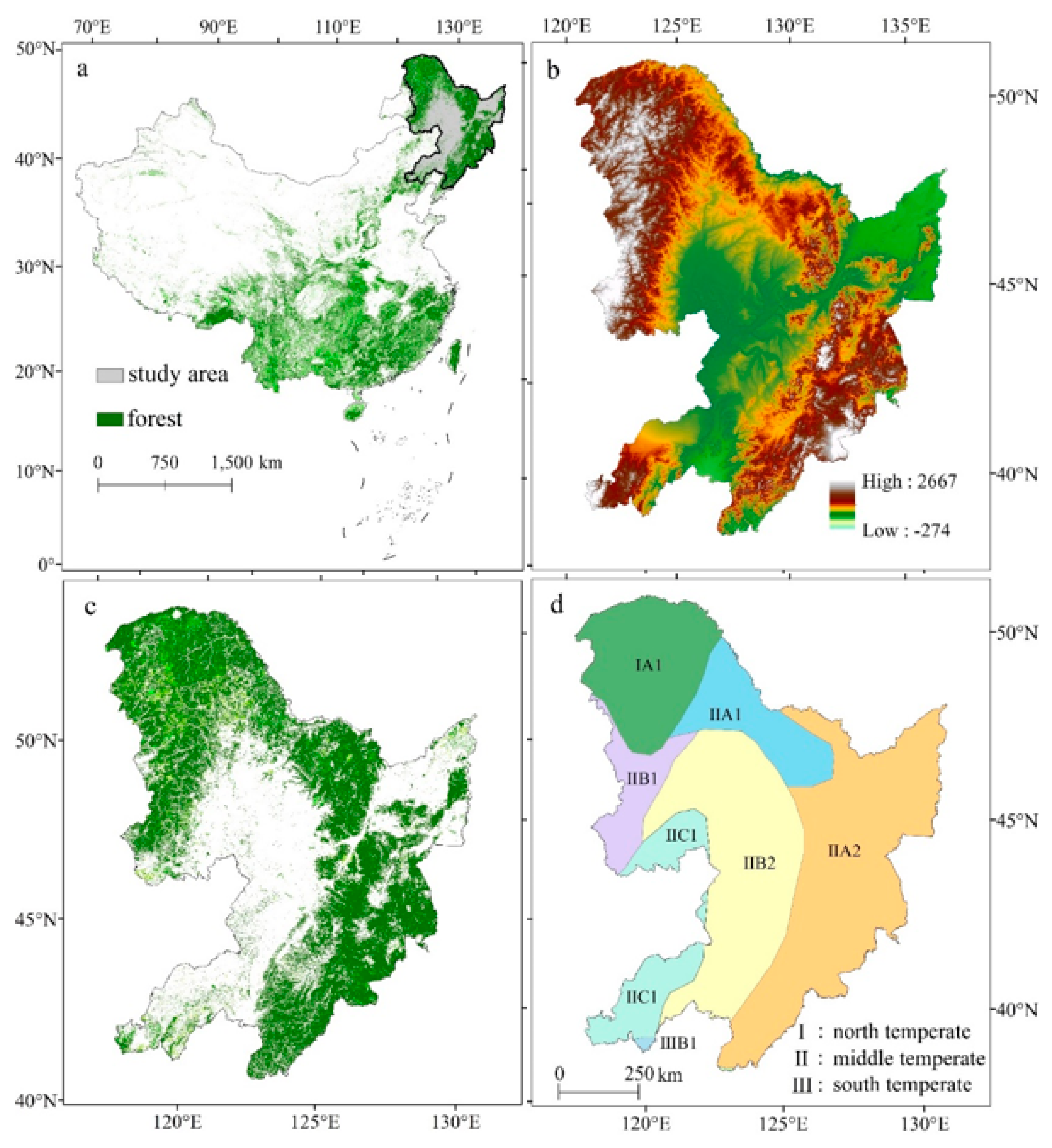


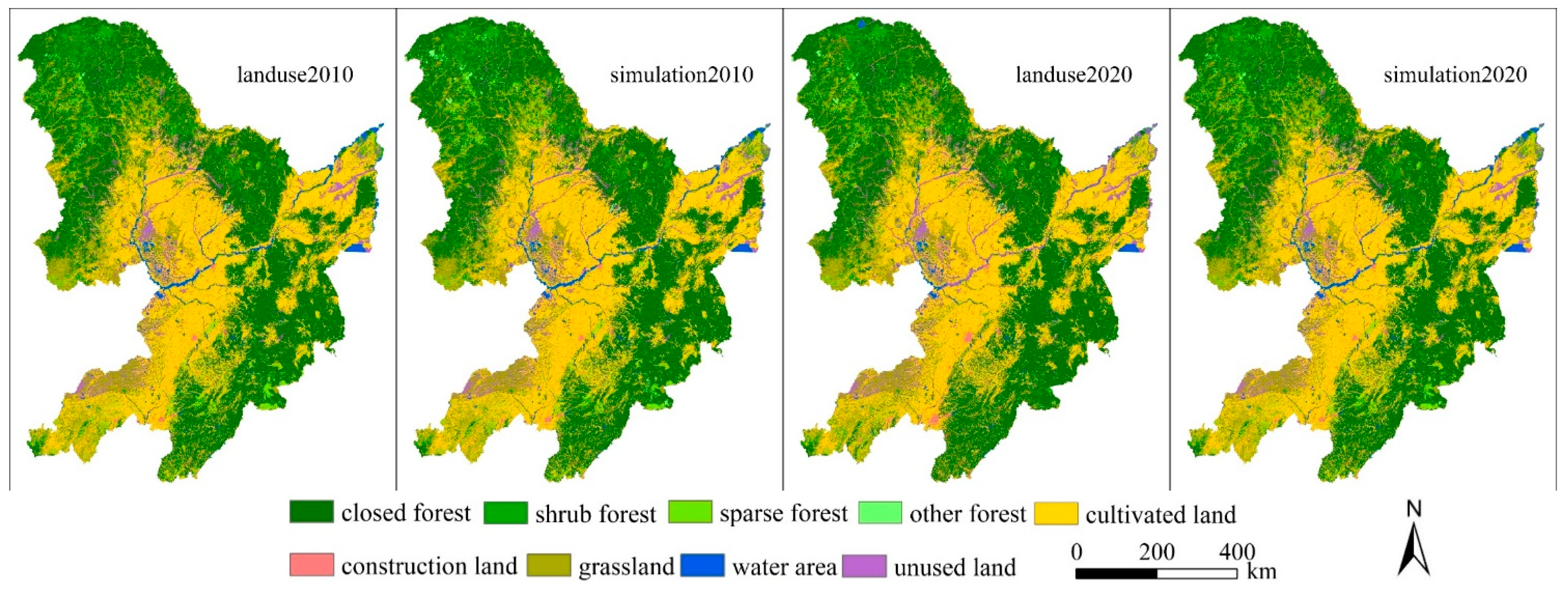
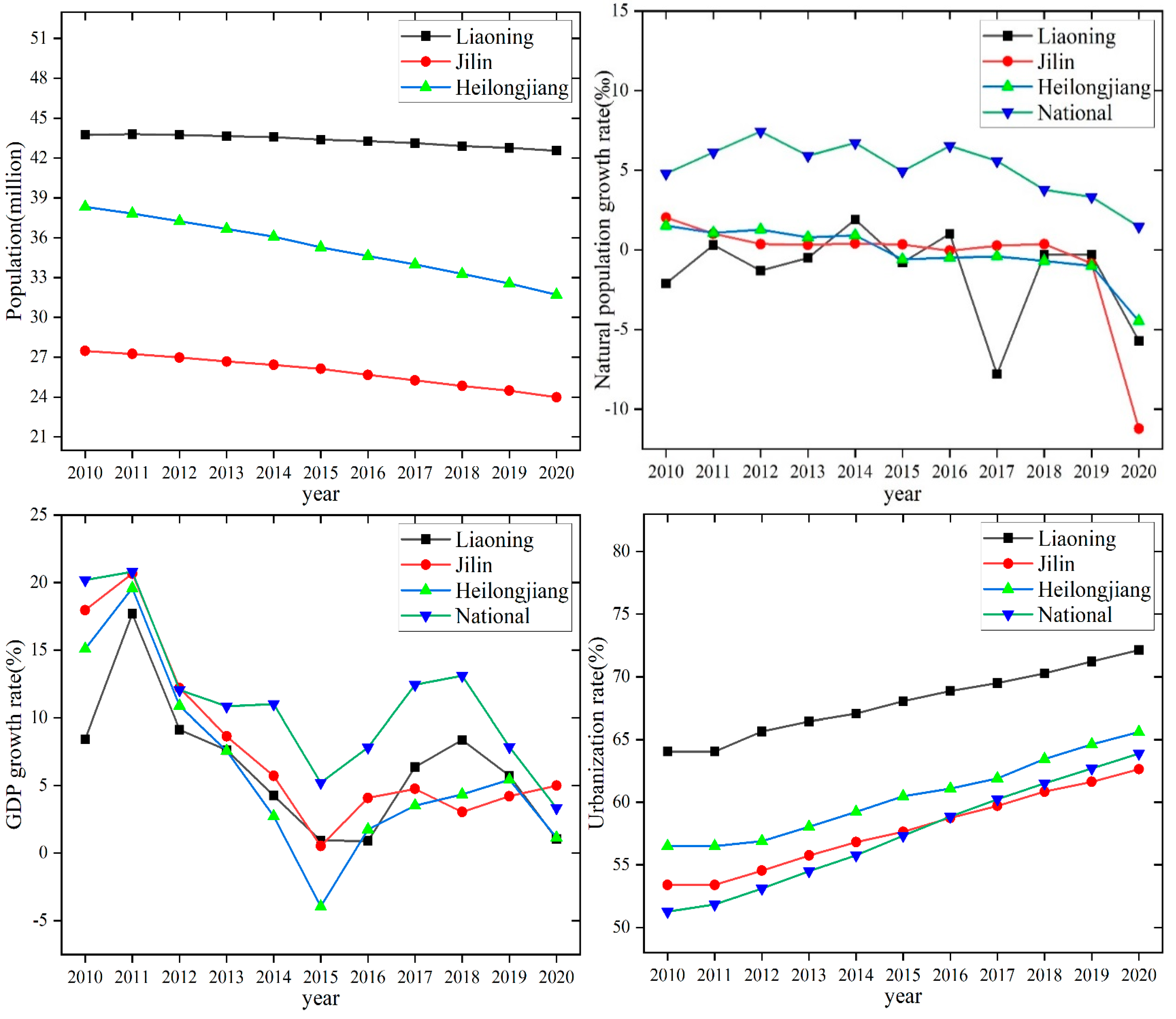

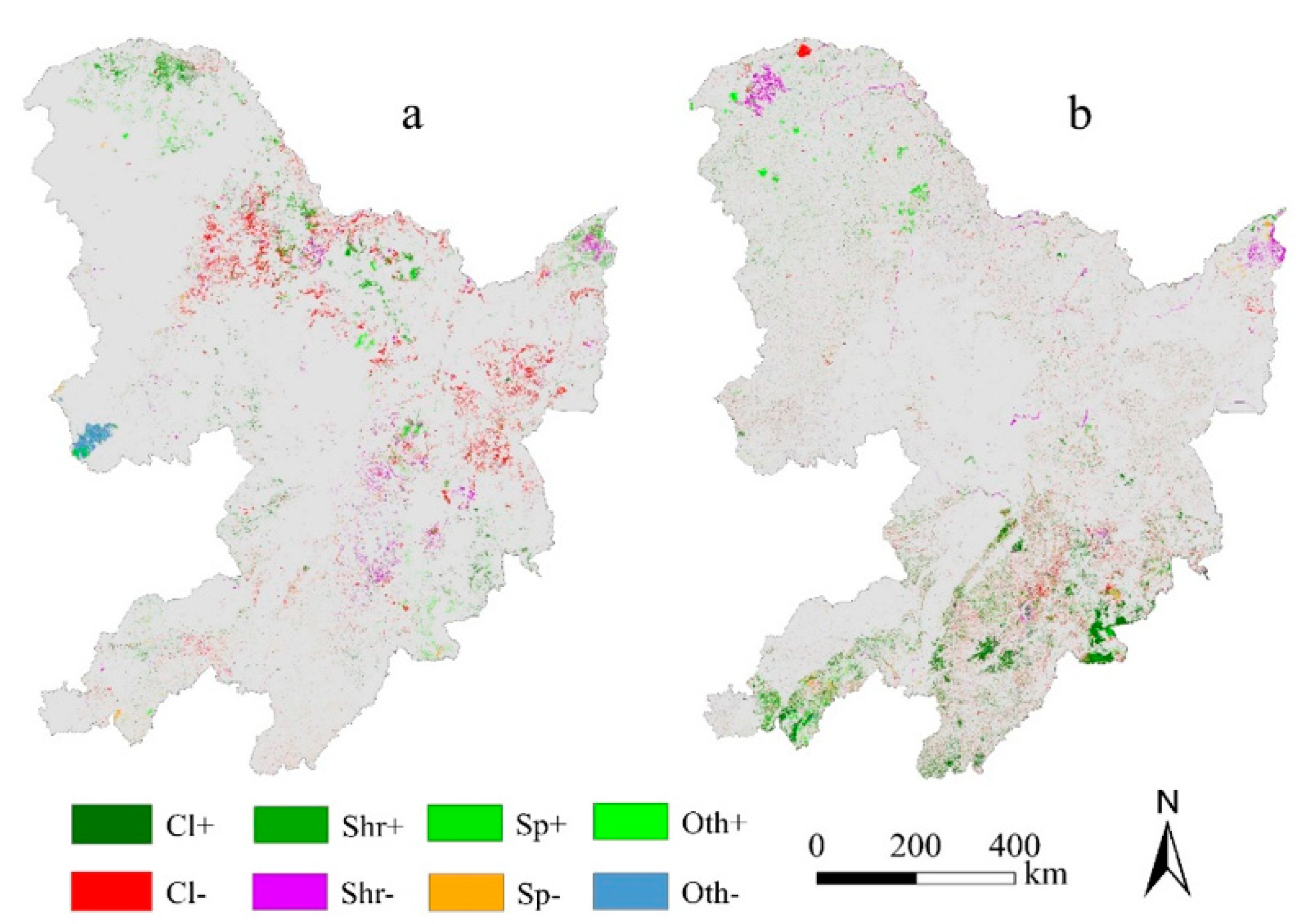
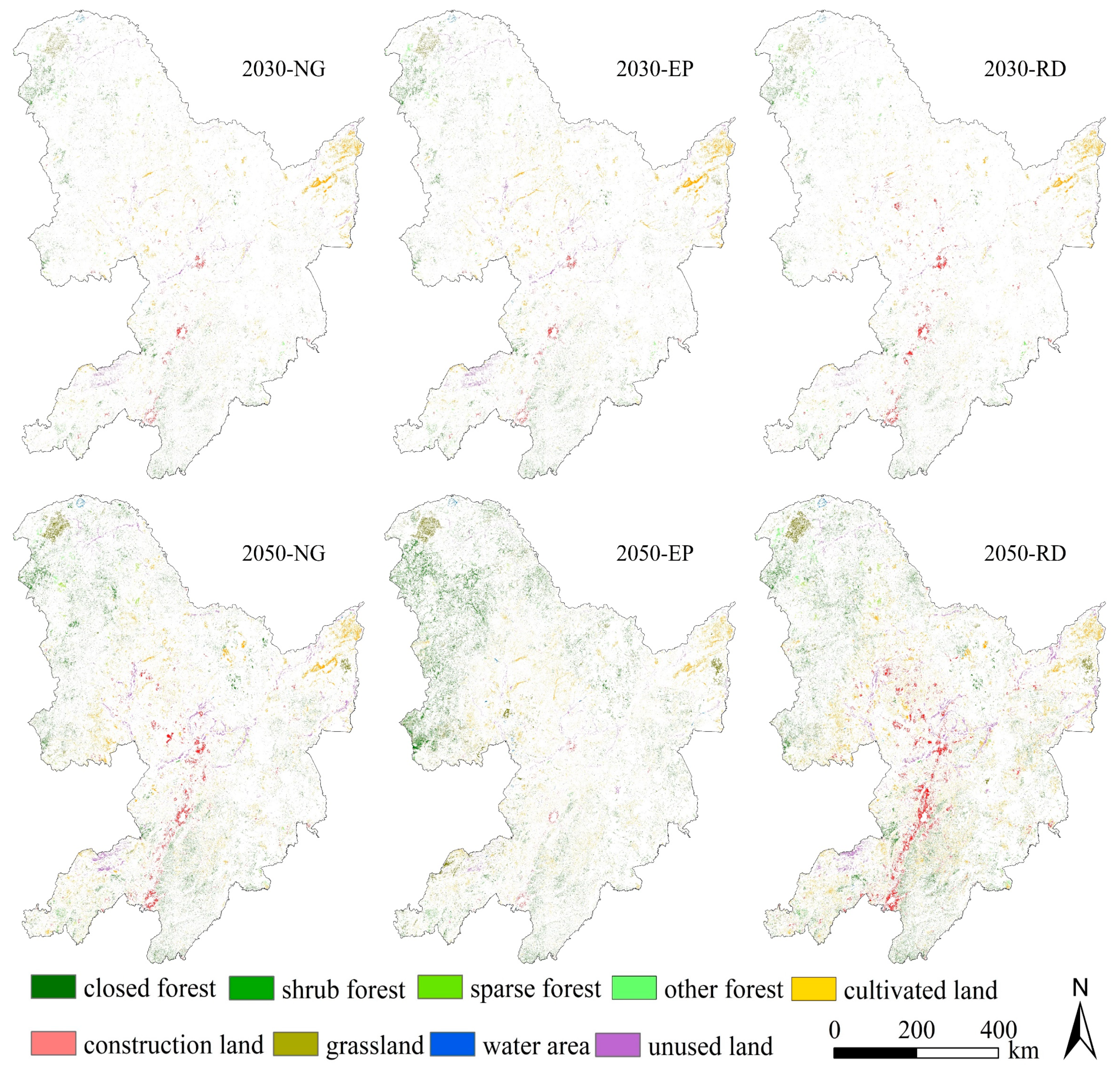


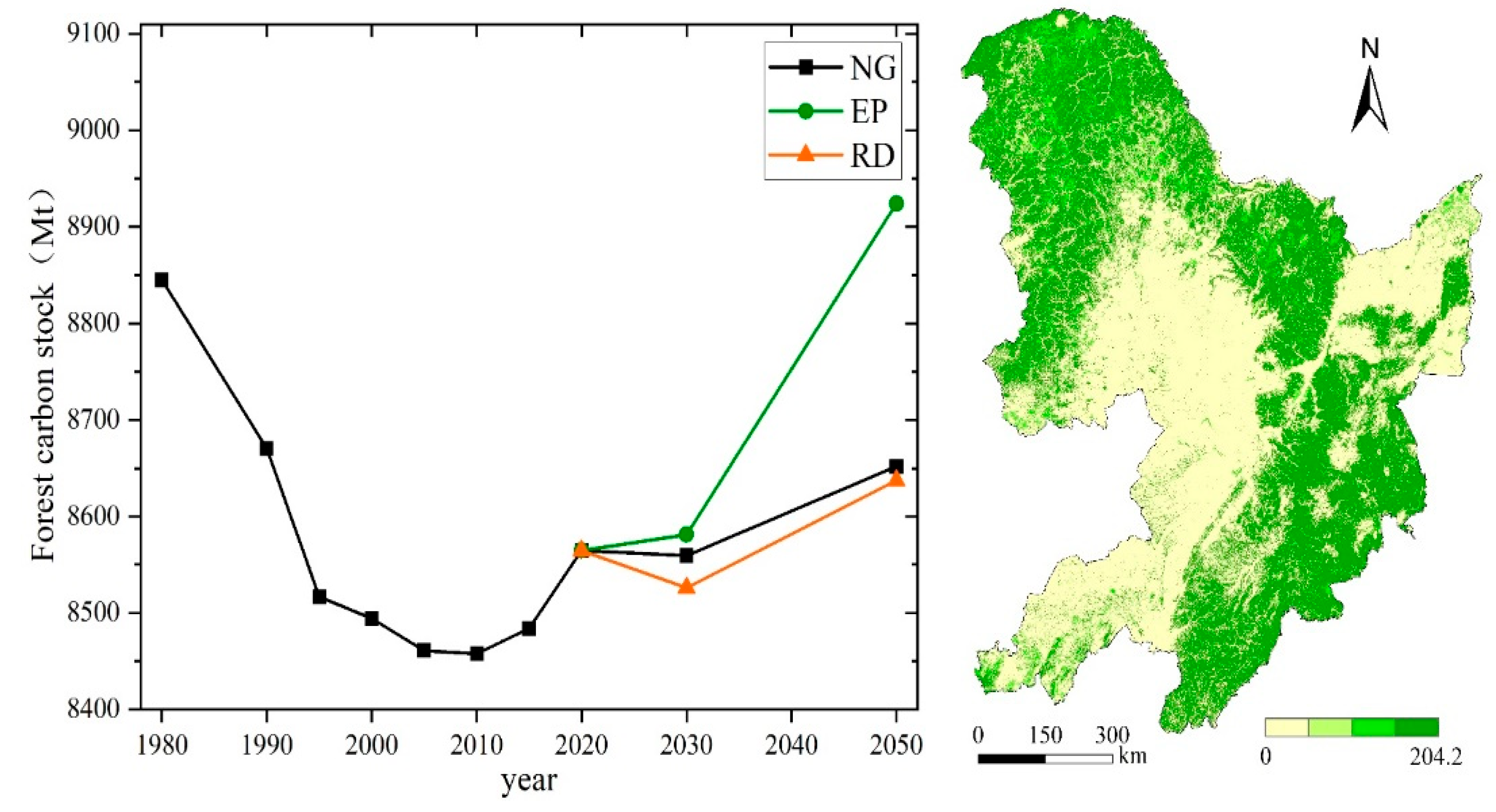
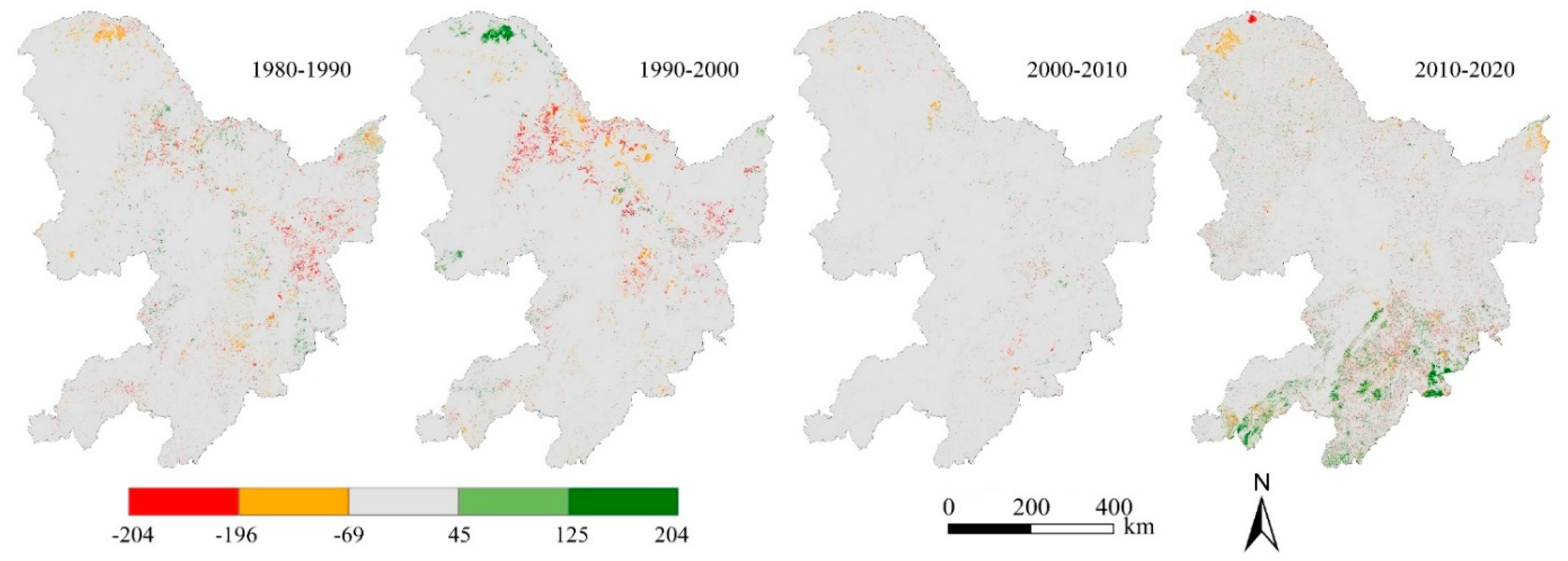
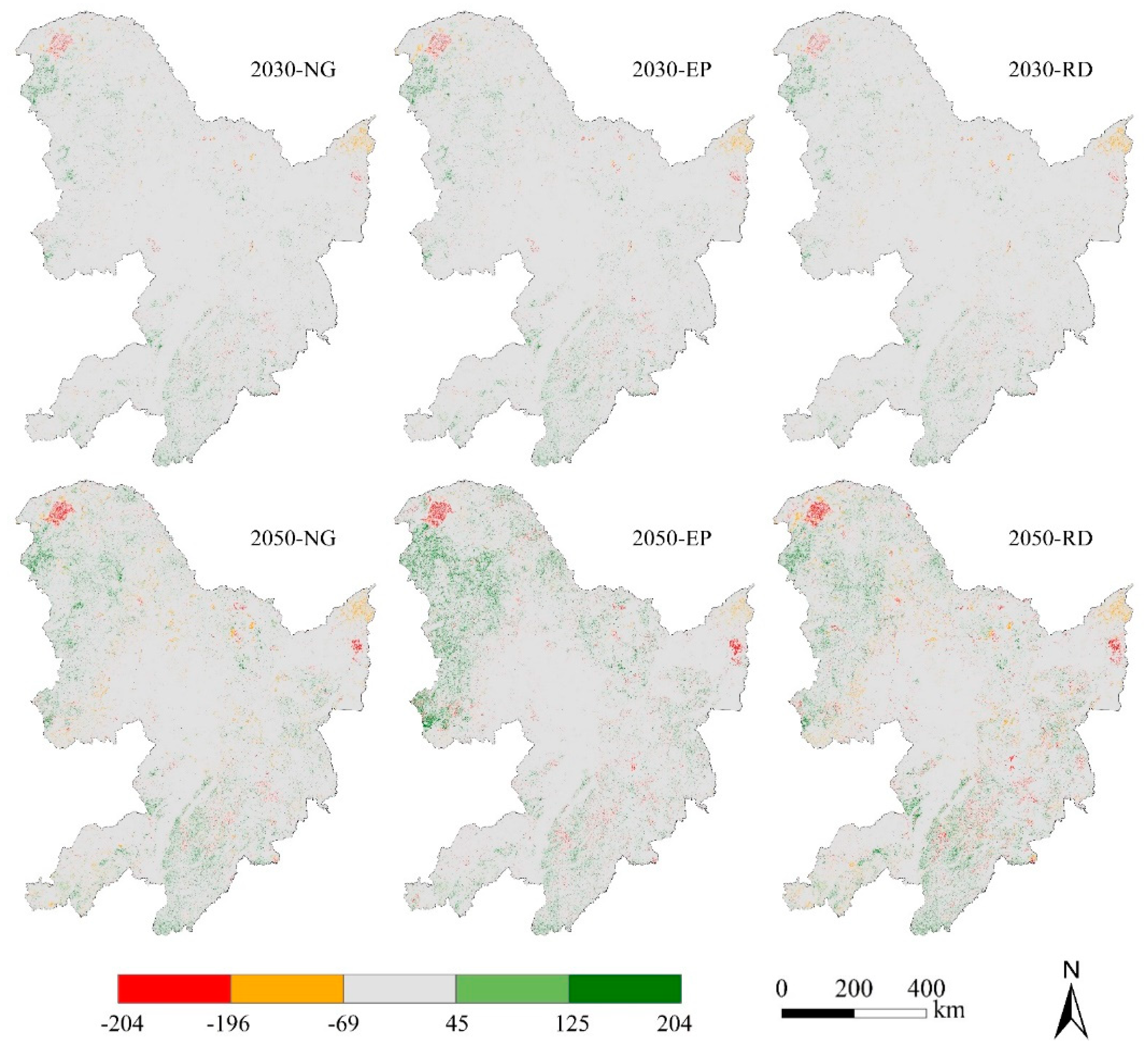
| Category | Data | Year | Original Resolution | Data Resource |
|---|---|---|---|---|
| Land | Land cover | 1980–2020 | 30 m | https://www.resdc.cn/, accessed on 28 December 2021 |
| Soil factors | Soil water capacity | 2017 | 250 m | https://data.isric.org/, accessed on 21 October 2021 |
| Soil pH | ||||
| Depth to bedrock | ||||
| Cumulative probability of organic soil | ||||
| Soil organic carbon stock | ||||
| Sand content | ||||
| Clay content | ||||
| Texture class | ||||
| Soil type | 1995 | 1000 m | http://www.resdc.cn/, accessed on 25 December 2021 | |
| Population | 1990–2020 | 1000 m | www.worldpop.org, accessed on 28 December 2021 | |
| Socioeconomic factors | GDP | 1990–2020 | 1000 m | http://www.geodoi.ac.cn/, accessed on 28 December 2021 |
| Proximity to city | 2015 | 30 m | ||
| Proximity to rural settlement | ||||
| Proximity to railway | https://www.openstreetmap.org/, accessed on 15 October 2021 | |||
| Proximity to highway | ||||
| Proximity to primary road | ||||
| Proximity to secondary road | ||||
| Proximity to tertiary road | ||||
| Proximity to quaternary road | ||||
| Climatic and environmental factors | DEM | 2016 | 90 m | NASA SRTM1 v3.0, accessed on 25 December 2021 |
| Slope | ||||
| Aspect | ||||
| Temperature | 1970–2000 | 30 arc-sec | http://www.worldclim.org/, accessed on 26 October 2021 | |
| Precipitation | ||||
| Bioclimatic variables | 2040–2060 |
| C_above | C_below | C_soil | C_dead | |
|---|---|---|---|---|
| Cl | 68.049 | 1.104 | 129.395 | 5.652 |
| Shr | 6.3325 | 0.733 | 115.73 | 1.23 |
| Sp | 17.57 | 0.765 | 58.67 | 0.62 |
| Oth | 1.288 | 0.688 | 6.15 | 0.643 |
| Land Use Type | User’s Accuracy | Overall Accuracy | Kappa Coefficient | |||
|---|---|---|---|---|---|---|
| 2010 | 2020 | 2010 | 2020 | 2010 | 2020 | |
| Closed forest land | 0.976457 | 0.956521 | 0.971922 | 0.896424 | 0.960604 | 0.853745 |
| Shrub forest land | 0.912785 | 0.729021 | ||||
| Sparse forest land | 0.818204 | 0.615643 | ||||
| Other forest land | 0.523307 | 0.664626 | ||||
| Cultivated land | 0.990825 | 0.918858 | ||||
| Grass land | 0.989463 | 0.850062 | ||||
| Water area | 0.990503 | 0.452974 | ||||
| Construction land | 0.966698 | 0.787961 | ||||
| Unused land | 0.98088 | 0.884863 | ||||
| Year | Cl | Shr | Sp | Oth | Cult | Gr | Wat | Constr | Un | |
|---|---|---|---|---|---|---|---|---|---|---|
| Current | 2020 | 391,734 | 30,785 | 23,168 | 4455 | 298,416 | 99,040 | 16,810 | 24,832 | 50,248 |
| M-C (2010–2020) | 2030 | 399,589 | 27,308 | 18,205 | 4422 | 298,167 | 94,962 | 13,757 | 27,733 | 55,347 |
| 2050 | 409,589 | 22,601 | 13,059 | 4356 | 297,974 | 88,148 | 10,889 | 31,782 | 61,091 | |
| M-C (2015–2020) | 2030 | 374,833 | 37,365 | 29,642 | 5583 | 303,196 | 109,299 | 12,431 | 26,080 | 40,666 |
| 2050 | 362,820 | 38,135 | 31,030 | 6016 | 312,674 | 111,450 | 10,378 | 27,684 | 38,907 | |
| Linear regression | 2030 | 393,992 | 28,049 | 20,529 | 4670 | 304,200 | 95,762 | 17,793 | 25,797 | 48,698 |
| 2050 | 402,772 | 22,099 | 12,649 | 4851 | 311,245 | 89,759 | 15,128 | 29,003 | 51,984 |
| Scenario | Time | Cl | Shr | Sp | Oth | Cult | Gr | Wat | Constr | Un |
|---|---|---|---|---|---|---|---|---|---|---|
| 2020 | 391,734 | 30,785 | 23,168 | 4455 | 298,416 | 99,040 | 16,810 | 24,832 | 50,248 | |
| NG | 2030 | 393,992 (0.58%) | 28,049 (−8.89%) | 20,529 (−11.39%) | 4670 (4.83%) | 304,200 (1.94%) | 95762 (−3.31%) | 17,793 (5.85%) | 25,797 (3.89%) | 48,698 (−3.08%) |
| 2050 | 402,772 (2.82%) | 23,066 (−25.07%) | 17,731 (−23.47%) | 3826 (−14.1%) | 303,334 (1.65%) | 93,759 (−5.33%) | 15,128 (−10.0%) | 29,003 (16.80%) | 50,869 (1.24%) | |
| EP | 2030 | 395,363 (0.93%) | 27,738 (−9.90%) | 20,614 (−11.02%) | 4505 (1.12%) | 303,010 (1.54%) | 98,694 (−0.35%) | 19,294 (14.78%) | 25,682 (3.42%) | 44,590 (−11.2%) |
| 2050 | 410,689 (4.84%) | 30,329 (−1.48%) | 20,343 (−12.19%) | 4296 (−3.57%) | 301,181 (0.93%) | 89,829 (−9.30%) | 19,261 (14.58%) | 26,220 (5.59%) | 41,342 (−17.7%) | |
| RD | 2030 | 392,892 (0.30%) | 27,485 (−10.72%) | 20,428 (−11.83%) | 4345 (−2.47%) | 302,019 (1.21%) | 95,404 (−3.67%) | 16,481 (−1.96%) | 27,605 (11.17%) | 51,519 (2.53%) |
| 2050 | 403,027 (2.88%) | 22,601 (−26.58%) | 15,922 (−31.28%) | 4314 (−3.16%) | 305,692 (2.44%) | 88,150 (−11.0%) | 15,087 (−10.3%) | 31,782 (27.99%) | 52,913 (5.30%) |
| Cl | Shr | Sp | Oth | Cult | Gr | Wat | Constr | Un | |
|---|---|---|---|---|---|---|---|---|---|
| Cl | 376,673.1 | 4660.43 | 1846.63 | 1422.39 | 13,858.13 | 2048.26 | 70.12 | 210.76 | 610.24 |
| Shr | 910.2 | 27,379.15 | 231.95 | 8.53 | 4618.52 | 390.24 | 94.45 | 72.51 | 270.6 |
| Sp | 139.94 | 30.82 | 26,721.09 | 15.22 | 1126.78 | 336.68 | 2.9 | 11.14 | 20.19 |
| Oth | 841.39 | 1418.53 | 374.15 | 2585.75 | 100.32 | 2157.42 | 0.11 | 1.46 | 2.86 |
| Cult | 1301.78 | 296.4 | 405.13 | 118.66 | 246,914.2 | 854.56 | 397.26 | 1913 | 744.18 |
| Gr | 2850.89 | 561.54 | 720.34 | 44.32 | 19,375.76 | 95,403.31 | 620.97 | 323.07 | 2639.85 |
| Wat | 11.42 | 42.86 | 12.96 | 0.01 | 608.65 | 228.91 | 20,076.5 | 6.93 | 203.48 |
| Constr | 4.03 | 0.89 | 0.73 | 0.06 | 82.26 | 35.81 | 4.25 | 18207.91 | 1.31 |
| Un | 185.1 | 643.1 | 191.78 | 1.1 | 10,392.48 | 1564.01 | 855.15 | 78.62 | 39,302.12 |
| Cl | Shr | Sp | Oth | Cult | Gr | Wat | Constr | Un | |
|---|---|---|---|---|---|---|---|---|---|
| Cl | 363,634.6 | 1956.55 | 2000.83 | 1156.92 | 7929.7 | 4131.44 | 889.67 | 412.75 | 805.53 |
| Shr | 3920.37 | 24,872.14 | 189.6 | 92.14 | 2209.96 | 2162.83 | 315.38 | 95.89 | 1175.43 |
| Sp | 7932.75 | 552.03 | 18,575.2 | 184.86 | 2081.31 | 774.25 | 68.56 | 175.24 | 160.57 |
| Oth | 1061.34 | 64.68 | 59.98 | 2745.78 | 154.4 | 68.52 | 7.25 | 19.38 | 14.71 |
| Cult | 8301.44 | 1573.53 | 912.24 | 107.58 | 27,2192.7 | 3315.28 | 1703.5 | 6855.78 | 2115.61 |
| Gr | 5600.76 | 1191.31 | 1310.58 | 126.6 | 4682.17 | 86,612.52 | 375.62 | 454.01 | 2665.66 |
| Wat | 356.83 | 356.31 | 21.81 | 2.29 | 1663.76 | 362.93 | 12,908.92 | 131.72 | 6315.43 |
| Constr | 232.88 | 68.58 | 36.79 | 7.41 | 3615.5 | 174.24 | 98.03 | 16,509.32 | 82.67 |
| Un | 693.08 | 149.48 | 60.64 | 31.26 | 3887.31 | 1438.61 | 443.68 | 178.01 | 36,912.84 |
| Time | Scenarios | Cl | Cult | Constr |
| 2030 | NG | 0.58% | 1.94% | 3.88% |
| EP | 0.93% | 1.54% | 3.42% | |
| RD | 0.30% | 1.21% | 11.17% | |
| 2050 | NG | 2.82% | 1.65% | 16.80% |
| EP | 4.84% | 0.93% | 5.59% | |
| RD | 2.88% | 2.44% | 27.99% |
| Cl | Shr | Sp | Oth | Cult | Gr | Wat | Constr | Un | |
|---|---|---|---|---|---|---|---|---|---|
| Cl | 383,252.2 | 45.37 | 141.3 | 353.05 | 1482.82 | 1308.46 | 13.52 | 53.53 | 190.5 |
| Shr | 916.5 | 27,396.88 | 35.14 | 5.19 | 1214.73 | 225.88 | 22.36 | 22.47 | 381.8 |
| Sp | 1988.78 | 19.68 | 20,111.64 | 45.25 | 644.18 | 152.24 | 8.7 | 9.9 | 85.97 |
| Oth | 521.78 | 3.31 | 11.07 | 3649.02 | 208.11 | 30.76 | 0.5 | 3.21 | 10.66 |
| Cult | 5549.88 | 146.03 | 66.06 | 354.81 | 285,028 | 173.65 | 19.97 | 2090.29 | 1968.61 |
| Gr | 2362.87 | 108.99 | 242.17 | 90.86 | 1339.2 | 92,655.55 | 54.09 | 88.11 | 1319.92 |
| Wat | 186.3 | 97.98 | 8.3 | 1.21 | 496.13 | 141.46 | 19,879.74 | 55.34 | 236.3 |
| Constr | 168.53 | 11.24 | 3.93 | 1.4 | 864.54 | 30.11 | 4.76 | 23366.41 | 97.31 |
| Un | 602.09 | 6.28 | 3 | 5.24 | 6670.99 | 116.95 | 81.8 | 48.55 | 40,535.08 |
| Cl | Shr | Sp | Oth | Cult | Gr | Wat | Constr | Un | |
|---|---|---|---|---|---|---|---|---|---|
| Cl | 376,941.9 | 515.61 | 74.16 | 284.3 | 4127.84 | 4854.85 | 50.62 | 27.19 | 248.59 |
| Shr | 321.41 | 28,882.61 | 11.11 | 14.78 | 682.76 | 184.08 | 13 | 8.15 | 117.83 |
| Sp | 1934.06 | 60.85 | 20,055.05 | 135.48 | 590.46 | 368.51 | 10.3 | 12.18 | 34.93 |
| Oth | 138.67 | 14.82 | 38.18 | 4295.95 | 3.34 | 70 | 0.21 | 7.26 | 8.06 |
| Cult | 6425.12 | 487.42 | 60.68 | 56.43 | 284,934.9 | 1237.56 | 111.78 | 1000.01 | 1139.77 |
| Gr | 22,647.28 | 304.62 | 130.7 | 129.49 | 3577.53 | 70,436.31 | 232.07 | 37.34 | 895.91 |
| Wat | 166.21 | 110.79 | 6.69 | 1.18 | 2913.05 | 128.31 | 15,474.72 | 112.33 | 2180.17 |
| Constr | 321.3 | 32.81 | 6.24 | 0.65 | 2846.75 | 115.81 | 17.39 | 21,095.38 | 112.55 |
| Un | 1950.38 | 44.5 | 4.04 | 0.45 | 4415.82 | 2630.77 | 192.48 | 40.11 | 38,791.88 |
Publisher’s Note: MDPI stays neutral with regard to jurisdictional claims in published maps and institutional affiliations. |
© 2022 by the authors. Licensee MDPI, Basel, Switzerland. This article is an open access article distributed under the terms and conditions of the Creative Commons Attribution (CC BY) license (https://creativecommons.org/licenses/by/4.0/).
Share and Cite
Sun, J.; Zhang, Y.; Qin, W.; Chai, G. Estimation and Simulation of Forest Carbon Stock in Northeast China Forestry Based on Future Climate Change and LUCC. Remote Sens. 2022, 14, 3653. https://doi.org/10.3390/rs14153653
Sun J, Zhang Y, Qin W, Chai G. Estimation and Simulation of Forest Carbon Stock in Northeast China Forestry Based on Future Climate Change and LUCC. Remote Sensing. 2022; 14(15):3653. https://doi.org/10.3390/rs14153653
Chicago/Turabian StyleSun, Jianfeng, Ying Zhang, Weishan Qin, and Guoqi Chai. 2022. "Estimation and Simulation of Forest Carbon Stock in Northeast China Forestry Based on Future Climate Change and LUCC" Remote Sensing 14, no. 15: 3653. https://doi.org/10.3390/rs14153653
APA StyleSun, J., Zhang, Y., Qin, W., & Chai, G. (2022). Estimation and Simulation of Forest Carbon Stock in Northeast China Forestry Based on Future Climate Change and LUCC. Remote Sensing, 14(15), 3653. https://doi.org/10.3390/rs14153653






